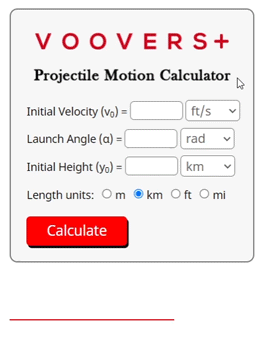Related Content
Projectile Motion Calculator


To get unlimited answers, .

Lesson on Projectile Motion
Lesson Contents
How to Hand Calculate Projectile's Trajectory
In physics, projectile motion is the study of how a particle or object moves when the only force affecting it is gravity. When a projectile travels through flight, the path it follows is called the trajectory. If viewed from the side, the trajectory is a parabolic shape (called a ballistic trajectory).
Imagine throwing a ball but there is no air to cause drag force on the ball. Once it leaves your hand, the only force the ball experiences is the gravitational force. The ball is considered a projectile and will follow a ballistic trajectory.
We can hand calculate the trajectory of a projectile with the kinematic equations. After rearranging and simplifying the equations to solve for projectile motion, they are given as:
vx = v0cos(α)
vy = v0sin(α)
t = 2vy/g
x = vxt
These equations are all we need to solve flight time and flight distance for a projectile that is launched from ground level (an initial height of zero). First, we plug the initial velocity (v0) and launch angle (α) into the vx and vy equations. This gives us the velocity components for the x (horizontal) and y (vertical) directions.
Then, we plug vy and gravitational acceleration (g) into the flight time (t) equation. Once we have determined flight time, we plug it into the distance (x) equation. After solving for x, we have successfully determined how far the projectile flies on its trajectory before reaching the ground.
How the Calculator Works
The calculator on this page is written in the programming language JavaScript. When you click the “calculate” button, the distancecalc function is activated and run by your internet browser’s JavaScript engine. The code that powers the calculator is very simple and uses the same kinematic equations as shown in the lesson above.
The calculator’s code also handles all unit conversions. Units that are not SI are converted to SI with basic conversion factors, such as 1 foot = 0.3048 meters. After all of the trajectory parameters are solved it converts the output units to the desired length units if they are not SI.
The code also has error-catching logic. If any numbers or characters that would cause an invalid answer or faulty calculations are inputted, calculations are halted, and the applicable error message is displayed.


